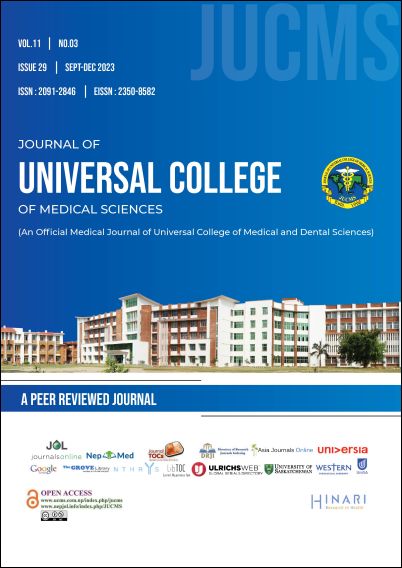Utility of Supine Stress Test to Anticipate Spinal Anaesthesia Induced Hypotension in Patients Undergoing Elective Cesarean Section
DOI:
https://doi.org/10.3126/jucms.v11i03.61471Keywords:
Supine stress test, Supine hypotension syndromeAbstract
INTRODUCTION Reduction in venous return caused by compression of the inferior vena cava by the gravid uterus, known as the supine hypotensive syndrome of pregnancy, is one of the reasons for particular susceptibility to hypotension at cesarean delivery. The hypotensive effect of spinal anaesthesia further exacerbates maternal hypotension in the supine position in term parturients. This study was conducted with the objective to evaluate the ability of supine stress test to predict spinal anaesthesia induced hypotension in patients undergoing elective cesarean section.
MATERIAL AND METHODS A prospective observational study was done among 232 singleton parturients scheduled for elective cesarean delivery under spinal anaesthesia in Universal College of Medical Sciences Teaching Hospital. Patients were subjected preoperatively to supine stress test and divided into two group of 116 patients each. SBP, DBP, MAP, HR were compared between two groups. Descriptive as well as inferential statistics were used to analyze the data.
RESULTS Supine stress test was positive by heart rate criteria in 50% of positive patient. The incidence of hypotension in positive test group was 73.3%, while it was 11.2% in negative test group, which was statistically significant (p<0.001).
CONCLUSION This study demonstrates supine stress test preferably can easily identify parturients in risk of developing hypotension during cesarean section under spinal anaesthesia.
Downloads
Downloads
Published
How to Cite
Issue
Section
License
Copyright (c) 2023 Journal of Universal College of Medical Sciences

This work is licensed under a Creative Commons Attribution-NonCommercial 4.0 International License.
Authors have to give the following undertakings along with their article:
- I/we declare that this article is original and has not been submitted to another journal for publication.
- I/we declare that I/we surrender all the rights to the editor of the journal and if published will be the property of the journal and we will not publish it anywhere else, in full or part, without the permission of the Chief Editor.
- Institutional ethical and research committee clearance certificate from the institution where work/research was done, is required to be submitted.
- Articles in the Journal are Open Access articles published under the Creative Commons CC BY-NC License (https://creativecommons.org/licenses/by-nc/4.0/)
- This license permits use, distribution and reproduction in any medium, provided the original work is properly cited, and it is not used for commercial purposes.




